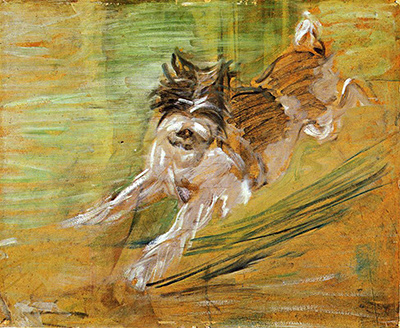Jumping Dog Schlick is part of the Städtische Galerie im Lenbachhaus collection, Munich, Germany. The museum has a large collection of artworks by The Blue Rider group of artists. Many were donated to them by a companion of Wassily Kandinsky, the artist Gabriele Münter.
In 1907 the German artist, Franz Marc, travelled to Paris to study paintings shown in the city's museums and galleries. During the visit, he was greatly influenced by the work of Vincent Van Gogh after seeing an exhibition of his work.
His response to Van Gogh's art is captured in his 1908 painting, Jumping Dog Schlick. The piece, oils on cardboard on wood, is in the style of the post-impressionists and has a swift, sketch-like quality.
The strong, fast brushstrokes indicate action and speed, making Schlick leap from the frame. Painted at the dog's level, Schlick is almost running off the canvas and the animal's excitement is palpable. The composition focusses on movement and energy, and the viewer is invited to experience the simple joy of leaping.
Marc often painted animals, thinking them purer than people. He intensively studied them and was a master at painting their anatomy. He wanted to distil their spirit into his work.
In the December of 1908, the same year he painted Jumping Dog Schlick, Marc wrote a letter to publisher Reinhard Piper describing how he wished to develop his art. He wrote, “I am trying to intensify my feeling for the organic rhythm of all things...” Marc's animal paintings started off naturalistic but gradually progressed until finally becoming cubist in style.
Primarily known as an influential expressionist painter and printmaker, Munich-born Marc was a founding member of the influential journal, Der Blaue Reiter (The Blue Rider) along with his compatriot, Wassily Kandinsky.
Sadly Marc was killed in action during World War I. He was 36 years old and just days away from being recalled from the front due to his protected status as an artist.




